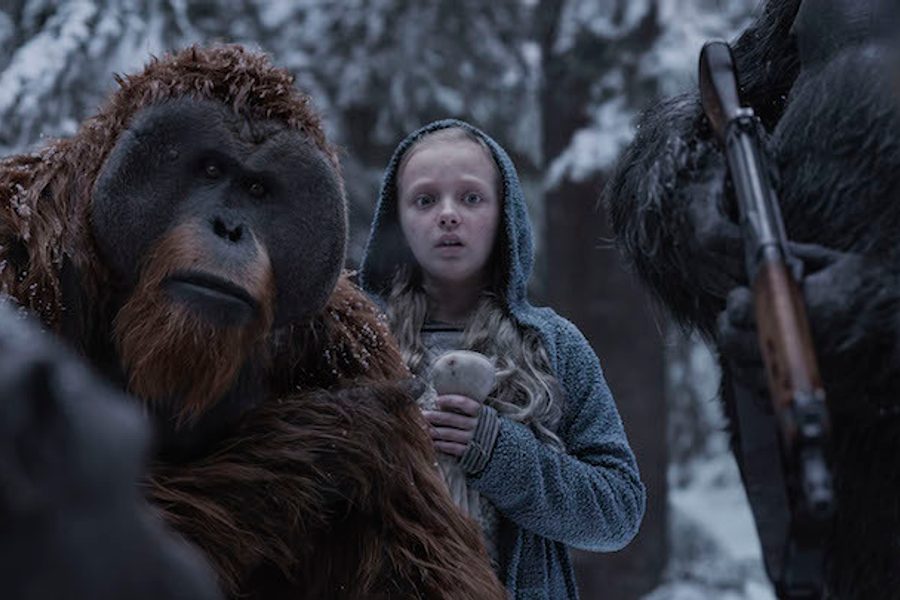War for the Planet of the Apes Lacks the Courage of Its Convictions
Koba should’ve won.
Eileen Jones

I’m a dedicated fan of the Planet of the Apes films. I’ve cheered on the recent reboots, starting with Rise of the Planet of the Apes in 2011 and followed by Dawn of the Planet of the Apes in 2014. For all their weaknesses (looking at you, James Franco), both had inspired action scenes, the brilliance of Andy Serkis as Caesar and the soaring dramatic power of ape revolution narratives. Their allusions to human revolutions through history made them thrilling allegories for activists on the Left.
So it saddens me to report that, though there are still great scenes of primate conflict, the third film of the trilogy succumbs in the end to fatal chicken-heartedness. I worried about the early signs in Dawn of the Planet of the Apes, where at times it seemed director Matt Reeves and his co-writer Mark Bomback opted for a wobbly false equivalence between the violent actions of oppressed apes and oppressor humans.
With War, Reeves and his team tie themselves into knots trying to avoid staging the all-out ape vs. human war promised in the title. They seem to be working from a mandate that says the corrosively vicious humans have to die somehow, but not at the hands of apes. So in the finale, we are treated to a series of deus ex machina disasters to rid the apes of these monsters. In its excess, it reminded me of a great old Daffy Duck cartoon called The Scarlet Pumpernickel, in which Daffy, pitching a script and trying to come up with the most awesome climatic action, starts desperately improvising catastrophes: “Then the dam broke! … The volcano erupted! … The price of foodstuff skyrocketed!”
To be fair, the beginning of the movie gives us some battle scenes, and they’re wonderfully gripping, shot in brooding 65 millimeter for maximum gravity. But ape casualties are high, and the new plan is to escape human territory altogether, ceding the northwestern forests to those nasty furless creatures not worthy of such sublime terrain. Caesar aims to lead his apes through the desert beyond into uninhabited territory, seeking a rumored paradise, like a chimpanzee Moses.
Before they go, the apes hole up for one last night in a system of caves masked from view by a waterfall. Because the place is so starkly beautiful, you know it has to be defiled horribly. Caesar, keeping watch by night, sees a mysterious green light flickering through the cascading water, reaches into it and finds the rappel lines of human soldiers already infiltrating the caves.
After the ensuing massacre, Caesar sends the survivors on their way to ape-paradise and heads back alone to kill the commanding officer responsible, the vile, bald-headed Kurtz-like figure “the Colonel” (Woody Harrelson in fine monomaniacal form).
If you don’t get that Apocalypse Now film reference right away, there’s some helpful graffiti on a wall later on to clue you in: “Ape-pocalypse Now.” There are also Bridge on the River Kwai citations, to give you a sense of Matt Reeves’ ambitions — he means to put his latest endeavor in the war film hall of fame.
And War for the Planet of the Apes is already garnering such admiring critical reaction, especially for its undeniably brilliant use of CGI, Variety put out a call to revive the “Special Achievement” Academy Award in its honor. Generally given to films with groundbreaking visual effects, it was last awarded in 1996 to John Lasseter and the Pixar team for Toy Story.
But Reeves’ ambition has its pitfalls. He risks imitating what was bad about highly praised war films as well as what was good. For example, do you remember that immensely long, draggy, talky, pseudo-profound scene with Col. Kurtz (Marlon Brando) late in Apocalypse Now that signals the end of all the film’s best stuff? Well, there’s a version of that scene midway through War, and it stops the movie dead and embalms it this time around, too.
The lack of war in this war movie is embodied by the nagging group of primates who insist on accompanying Caesar on his assassination mission, led by moralizing orangutan Maurice (Karin Konoval). Maurice never lets up on telling Caesar revenge is wrong. “You sound like Koba,” he warns, referring to the scarred bonobo survivor of human lab experiments who, in Dawn of the Planet of the Apes, undercuts Caesar’s authority and seeks total war with humans.
But that’s the thing — fundamentally, Koba wasn’t wrong. All-out war was always on the horizon.
Along the way the small band of apes searching for the Colonel run across a little girl (Amiah Miller) in an abandoned village who’s been rendered mute by the Simian Flu that killed off most of the human population. The Colonel believes this mutism brings humans closer to animals, which maddens him and drives him to annihilate the apes along with any humans displaying such symptoms.
I found myself silently begging Matt Reeves, “Not a mute little girl, like something out of an old D.W. Griffith melodrama. Please.” But, because Maurice insists that they bring her along, from then on every ape in the band has to have a touching moment with the girl to teach them that human beings aren’t all bad. Don’t even get me started on the scene with the big gorilla Luca (Michael Adamthwaite) lovingly placing a pink flower behind her ear.
Then they pick up a chimp named Comic Relief who’s hiding from “the bad place,” a concentration camp run by the Colonel. In it, imprisoned, starved and tortured apes are made to build a wall to keep out the other highly militarized faction of humanity that opposes the Colonel. The wall is the sign of the mad military delusion, as is the bridge in Bridge on the River Kwai. (It’s also a topical jab at Trump’s delusional border wall between the U.S. and Mexico.)
I was just kidding about the name Comic Relief. The former zoo chimp, now surviving as a timid scavenger, calls himself Bad Ape (Steve Zahn), illustrating how non-radicalized apes have internalized the standards imposed on them by humans. Elsewhere, ape servants working for the humans answer to the name of “donkey” (presumably after the beast of burden as well as the Donkey Kong game) and accept their degrading treatment in vain hopes of being allowed to survive the human vs. ape war.
So the scene is set for a final confrontation. You cherish hopes of all the imprisoned apes breaking out and ferociously running down their fleeing human tormentors, of all the “donkeys” simultaneously turning on their “masters,” and of Caesar ripping out the Colonel’s beating heart and making him eat it.
Or maybe that’s just me.
There’s a wonderful moment when Caesar admits, “I am like Koba,” so damaged by contact with humans that he no longer sees any way out of total war against humanity. After capture and subsequent escape, he goes back for a reckoning with the Colonel, who’s hiding out in his lair perched at Nuremburg Rally height above the men who worship him. At that point, you’re almost fooled into thinking, “Finally. Now it’s on. Concentration camp means violent reprisals are justified.”
But at the same time, you already know you’re stuck with the wheezy old revenge plot that demonstrates how revenge solves nothing and only hurts the avenger. It’s one of the rare ways in which genre films tend to fail us. They’re usually our friends, providing us with everything that’s routinely denied us, excitement and plentiful erotica and breathtaking action and zowee spectacle and self-indulgent pleasures galore. But though we almost never get revenge in real life, and any working-class person knows what it’s like to be kicked around while never daring to kick back, popular films rarely give us complete, uncompromising, feel-good revenge.
Countless times we’ve watched vengeful protagonists for solid two-hour blocks on the trail of the evil bastards who wronged them, only to have them decide at the end that revenge is wrong, or beneath them, or that the ultimate punishment is to let the bastards live so they can think about what they’ve done. It’s embittering — and in this case, puzzling. Why spend a whole movie teaching Caesar to empathize with humanity once again? That’s where he started all the way back in Rise of the Planet of the Apes, loving humans who relentlessly betrayed him and his fellow apes. And look how well that’s generally turned out for him!
Not least among the puzzling factors in this film is a weird flourish at the end when a hopeful glimpse of an uninhabited promised land appears to be shot in direct imitation of John Ford Westerns. First we see the grand craggy mesas of Monument Valley, then the sky near sunset that looks as if it were painted by one of the Old Masters over the valley of promise below. Can Reeves mean to present this Fordian image straightforwardly as a genuine glimpse of America’s promise?
It’s weird because most of us have a different attitude now toward Ford’s visions of the West as unspoiled paradise than people did back in the 1940s. Hell, by the end of his career, Ford didn’t seem to think they were so hot either, as he increasingly took on the racism, empty jingoism, vigilante violence and economic exploitation built into America’s experimental democracy. The falseness of that utopian vision of American exceptionalism, or at the very least, the compromising shadows that should always have been included in it, would come to haunt Ford in grim late-career films like The Searchers, The Man Who Shot Liberty Valance, Sergeant Rutledge and Cheyenne Autumn.
I like to think Matt Reeves and his team realize the complex implications of going back to Ford to show us the promise of our civilization, and are teeing up the Apes sequel in properly foreboding terms.
Maybe Downfall of the Planet of the Apes next time?







